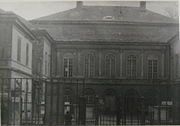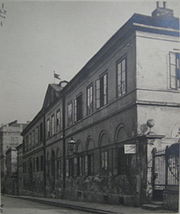
Czartoryski-Schlössel
Encyclopedia


Palace
A palace is a grand residence, especially a royal residence or the home of a head of state or some other high-ranking dignitary, such as a bishop or archbishop. The word itself is derived from the Latin name Palātium, for Palatine Hill, one of the seven hills in Rome. In many parts of Europe, the...
in the Währing
Währing
Währing is the 18th district of Vienna, Austria. It is in the northwest part of the city. In addition to currently hosting a number of Vienna's foreign embassies, Währing was the site of the original burial places of composers Ludwig van Beethoven and Franz Schubert.-Location:Währing lies in the...
district of Vienna
Vienna
Vienna is the capital and largest city of the Republic of Austria and one of the nine states of Austria. Vienna is Austria's primary city, with a population of about 1.723 million , and is by far the largest city in Austria, as well as its cultural, economic, and political centre...
, Austria
Austria
Austria , officially the Republic of Austria , is a landlocked country of roughly 8.4 million people in Central Europe. It is bordered by the Czech Republic and Germany to the north, Slovakia and Hungary to the east, Slovenia and Italy to the south, and Switzerland and Liechtenstein to the...
. It was built in 1807 for the banker Friedrich Jakob van der Nüll, the father of architect Eduard van der Nüll. The palace was subsequently put up for sale and purchased by Prince Czartoryski
Czartoryski
Czartoryski is the surname of a Polish-Ukrainian-Lithuanian magnate family also known as the Familia. They used the Czartoryski Coat of arms and were the leading noble family of the Polish-Lithuanian Commonwealth in the 18th century.-History:The Czartoryski is a family of a Grand Ducal...
; it remained in possession of the Czartoryski family until shortly after World War I.
The three-storey-high palace was designed in the Empire
Empire (style)
The Empire style, , sometimes considered the second phase of Neoclassicism, is an early-19th-century design movement in architecture, furniture, other decorative arts, and the visual arts followed in Europe and America until around 1830, although in the U. S. it continued in popularity in...
style. The layout was shaped like a horseshoe, with a central part (Mitteltrakt) and two side wings. The building was set back from the street by a courtyard, protected by a wrought-iron fence with a gate. Before selling the palace, the Prince had the expensive inlaid doors and wooden floor removed and transported to his estate in Jarosław, Galicia, where they were destroyed in a fire during World War I. The palace's remaining features included the elaborate ceiling in the former library, showing depictions of mythological scenes, as well as the stucco
Stucco
Stucco or render is a material made of an aggregate, a binder, and water. Stucco is applied wet and hardens to a very dense solid. It is used as decorative coating for walls and ceilings and as a sculptural and artistic material in architecture...
in the former gallery.
After the palace was renovated in 1923, it re-opened as a children's home. The building suffered slight damage during World War II, and subsequently fell into neglect. It was torn down in 1957 to make way for a modern school building, completed in 1959.

